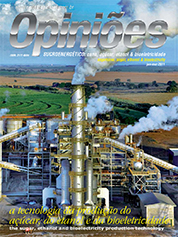Paulo Estevão Lemos de Oliveira
Professor of Sugar Technology at the UFPE
Op-AA-27
State-of-the-art in the crystallization process in Brazil
Art and science of the crystallization of sucrose coexist in sugar mills in Brazil and also in all other producing countries of the world. However, in Brazil one must reduce art so that the science of crystallization may occupy an adequate space.
This science relates to the development of modeled vacuum pans using computer tools, the choice of continuous vacuum technology, mainly for low purity massecuite, automation logic and control capable of reducing process variability, proper use of cooling crystallization, energy integration of process and, more importantly, trained manpower making use of the information technology currently available.
Deviations from such premises impact the operational cost of the process, result in poor sugar quality and in low productivity of crystallization. In this respect, four indicators will be considered in an analysis of crystallization performance of high and low purities:
- The first relates to retaining sucrose in the crystals during the crystallization process (SJM). This indicator represents the operational efficiency of crystallization, given a certain condition of the raw material that feeds the process. Values under 86% represent unsatisfactory performance, and such performance results from a number of operational causes.
However, our assessment focuses on the adopted premises for the implementation of projects and production arrangements, which premises consider little retention, so as to favor the operation of the distilleries, to the extent that, in the end, better molasse with a higher concentration of total reducing sugars will be sent, or even due to a financial adjustment that implies the reduction and cutting back of investments in the project.
Such decisions must be well analyzed, taking into account the cost of energy, sucrose losses due to thermal degradation, and the cost of production inputs, in accordance with a sugar cane transference strategy for the production of ethanol in which, in the end, a molasse rich in sugar is adopted.
- The second indicator relates to the productivity of vacuum pans. This indicator depends on the following process variables: crystal yield in the massecuites, total operational cycle time for the batch vacuum pans and residence time for continuous vacuum pans. Low productivity has several operational causes, but we shall only comment on the benefits of introducing continuous vacuum pans as quickly as possible in mill operations.
It is known that, in Brazil, many mills, when they expand their installed capacity, or even when installing greenfield projects, opt to invest in vacuum batch pans, basically because of lower equipment costs compared with continuous vacuum pans.
The continuous vacuum technology has major advantages, eliminating all inefficiencies of the batch operation cycle, including: times that do not aggregate value to the process, significant reduction in the cost of operational labor, minimization of maintenance costs and higher crystal yield in the massecuites.
- The third indicator refers to the automation level of this process. It is a fact that in recent years the mills undertook major efforts to invest in automation and control of their processes. As pioneers of this effort, for a long time we saw investments being made and benefits being reaped due to the automation of the feeding process in milling.
Nowadays, one can say that practically all units operate their mills with highly efficient control systems. In this respect, the benefits from the automation of vacuum pans must be converted to gains in productivity, quality and operational safety. Therefore, they must be included in the feasibility analysis of the investment.
- The fourth, and certainly most important indicator, is the one that relates to training a company’s human resources. It is essential there be an indicator to measure the performance of human resources in the mills. Continuous education of the workforce must be encouraged so that one may prevent absolute labor shortage. The investment in qualifying the workforce has the best payback I know of, because the ROI is immediate.
Finally, I wish to comment on the good phase the industry is enjoying in terms of sugar prices, to show that the boiling and the cooling crystallization operations play important roles in keeping up the mills’ performance in terms of bottom line results. Historically, we are aware of the cyclical pattern of sugar prices. We trust that strategic and technological initiatives may warrant the mills’ profitability levels to be acceptable in times when prices are falling. Furthermore, we also acknowledge the proficiency of executives in conducting the difficult and strenuous task of financially managing such business initiatives.




